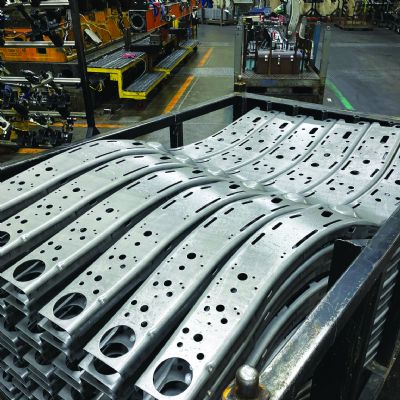 Peter Ulintz
Peter UlintzPressing Questions?
October 1, 2009Comments
The next few issues of Tooling by Design will be presented in a question and answer format. This format allows the reader to actively participate in the column’s content. The intent is to more closely align the topics with the needs and interests of its readers.
In order for the Q&A format to work, I need your participation. I encourage readers having tool and die or metal-stamping-related questions, to e-mail me at: https://www.metalformingmagazine.com/pete.ulintz@toolingbydesign.com. I will try to answer as many questions as possible in this column. If your question is not answered in this column, it will be answered by e-mail.
Here is a sampling of some questions I have recently received:
Q: I recently read your column on forming aluminum stampings (May 2009). We manufacture commercial food service equipment. One of our products is an aluminum baking pan produced from 0.040-in.-thick 3003 material. The pan is 18 x 26 in. x 1 in. deep and takes four operations to produce the finished product: draw, trim, partial form and final form. A light lubricant (oil) is applied mechanically to the coil prior to the initial stamping. The residual oil must be cleaned prior to packing, which is done in a closed vapor-degreasing process. My question is, do you know of a “hard-coating” that could be applied to the forming dies to eliminate the lubricant? Our desire is to eliminate the cleaning process and the associated costs.
A: The short answer to your question is, no. Now the longer explanation.
In general, many steel parts can be produced using only the residual corrosion-inhibiting mill oil on the coil. The primary reason is that any ferrous oxide that develops on the surface has the ability to deform. But oxides found on aluminum surfaces are quite different. Aluminum oxide is very hard, brittle and tightly adhering. The brittle oxide tends to break, allowing highly adhesive metal-to-metal contact.
Did you know the most commonly used grinding-wheel abrasives are aluminum-oxide compounds? That’s right, the same oxide that forms on the surface of your aluminum sheetmetal.
Several studies have shown that the surface hardness of tools does not have a statistically significant affect on tool buildup when forming aluminum stampings without lubricants. Even with very hard surface coatings, the aluminum-oxide film is still hard enough to cause die damage. In deep drawing, a very small surface scratch (damage) will result in galling after just a few hits.
When forming aluminum it is imperative to separate the sheetmetal from the die surface. Lubricants formulated specifically for aluminum stamping operations provide a tenacious barrier between the die surface and the oxide film on the blank. With the proper stamping lubricant, the blank avoids intimate contact with the tool surface. Common practice should include lubricating both sides of the blank to reduce galling tendency.
Here’s an alternative option for you to consider: Polyethylene (PE) or polyvinylchloride (PVC) plastic films can be applied to the aluminum surface to aid drawing and protect the surface finish. These films provide excellent lubrication with friction coefficient values below that of oil. PE suffices for most applications but PVC may be required for severe draws and multiple forming operations. Unfortunately, both can be difficult to remove.
Q: I just finished reading your article on pressure strippers in the July/August 2009 issue of MetalForming. The illustration in Fig. 2 shows two screws mounted with the heads down and they are labeled as nylon screws. Is this correct? Is it safe to use nylon screws in a stripper?
A: You are an astute observer. The screws in the illustration are labeled incorrectly. They should have been labeled “Nylock” screws. A nylon screw would not provide the strength required in a stamping die and should never be used.
The Nylok Blue Patch is a self-locking element permanently spray-bonded onto the threads of a fastener. When the mating threads are engaged, the tough, resilient blue nylon patch element is compressed and a counterforce is created to establish a strong metal-to-metal contact and positive resistance to vibration and loosening. This eliminates fasteners from falling out and dropping onto the lower die during die operation. And, they’re reusable.
Q: I read your article on the topic of forming stainless steel (February 2009). I found the article to be very interesting and pertains directly to my company.
We have recently received several projects where the specified material has been stainless steel, which is not a common material for us. We have been making good parts and maintaining the tool fairly successfully, except for the first draw-form tool. The inserts in the lower form are the issue. We have tried several different types of tool-steel inserts with different types of coating. The result has als been the same—galling is almost immediate. We have had some success with the aluminum-bronze inserts you talked about in your article. The bronze does not gall at all, but is does wear out rapidly, causing us to have to recut and shim this station quite often. Any suggestions?
A: After reviewing the pictures sent, it is clear that the problem lies in an area on the part where material thickening is to be expected when deep drawing. Additional punch-to-die clearance must be provided in this area to avoid immediate galling. Austenitic grades similar to what you are using can increase in thickness as much as 30 to 40 percent, depending on the amount of deformation. This is a much greater percentage than you may be used to with low-carbon steels. You must verify that the die clearance is correct, or correct the deficiency, before attempting any other solutions.
Next, make sure that the draw lubricant you are using is designed for stainless steel. Forming stainless steel generates very high friction where the sheetmetal and die surfaces meet. This friction is converted into high heat energy capable of breaking down draw lubricants commonly used to stamp low-carbon steel. In your case, an extreme pressure (EP) lubricant with very high film strength and super wetting characteristics developed specifically for stainless steel may be required. MF
View Glossary of Metalforming Terms
Technologies: Lubrication, Materials, Tooling









 White-paper
White-paper